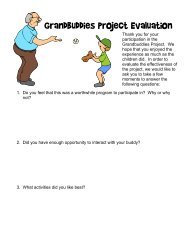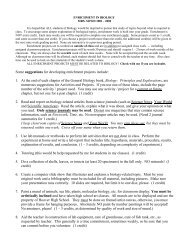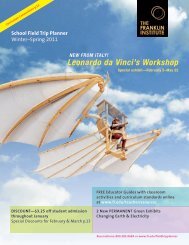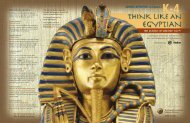Preface - The Franklin Institute
Preface - The Franklin Institute
Preface - The Franklin Institute
Create successful ePaper yourself
Turn your PDF publications into a flip-book with our unique Google optimized e-Paper software.
<strong>Preface</strong><br />
What is NSP?<br />
<strong>The</strong> National Science Partnership for Girl Scouts and Science Museums (NSP)<br />
establishes partnerships between Girl Scout councils and science-strong<br />
institutions across the nation to promote science interest and knowledge in young<br />
American girls. Through the National Science Partnership, led by <strong>The</strong> <strong>Franklin</strong> <strong>Institute</strong><br />
and Girl Scouts of the U.S.A., seven hands-on science activity kits and accompanying<br />
training workshops are offered to Girl Scout leaders across the country, assisting them<br />
in conducting science activities directly linked to the Girl Scout recognition requirements<br />
for Brownie and Junior Girl Scouts.<br />
NSP Workshops and Activity Kits<br />
NSP workshops provide an opportunity for leaders to explore hands-on science<br />
activities with other leaders. Although leaders will not necessarily have time to try every<br />
activity in the kit during a workshop, activities found to be the most enjoyable or<br />
challenging have been included in each workshop.<br />
Ideally, each leader should receive the kit for the workshop in which she is<br />
participating. Each science activity kit includes the appropriate “Leader Guide” and a<br />
box of hard to find materials. (<strong>The</strong> materials in the kit are meant to be<br />
consumed, since many of the activities will result in projects the girls can take home to<br />
share with their family and friends.) Activities in the Leader Guide are organized by<br />
“week” and are designed to be completed in sequential order during a course of 5 to 7<br />
weeks of troop meetings. However, recognizing the different needs of troops and<br />
leaders, the program is also designed to allow for flexibility. <strong>The</strong> NSP activities can be<br />
tailored to suit a variety of models, needs, audiences and situations, such as “Girl<br />
Scouting in the School Day,” large events for girls, science theme days, and summer<br />
camp programs.<br />
Science Wonders<br />
Preparing to do the Workshop<br />
<strong>The</strong> purpose of the Science Wonders workshop is to familiarize Brownie Girl Scout<br />
leaders with the activities in the Science Wonders kit by having them do many of the<br />
activities themselves. This outline is to be used in conjunction with the “Science<br />
Wonders” Leader Guide and the “Science Wonders” Master Kit which provide all the<br />
instructions and materials to conduct this workshop.<br />
Background<br />
Leaders who attend these training workshops are generally mothers of Girl Scouts or<br />
community volunteers. <strong>The</strong>y have a common desire to strengthen their troop’s science<br />
program. <strong>The</strong>y are not paid to attend the workshops and most have juggled busy<br />
schedules to be with you. Some of the leaders may say that they were “not good at<br />
science in school” and some may even admit to being afraid of science. However, some<br />
may have science-related jobs or backgrounds and will be more confident in their<br />
science abilities. It is important not to let these individuals overshadow the rest. <strong>The</strong> aim<br />
of this workshop is to familiarize leaders with the activities and concepts presented in<br />
the kit in a non-threatening, cooperative environment.
Set-Up<br />
<strong>The</strong> optimal number of participants in the training workshops is 15-25. Since this is a<br />
“hands-on” experience, work tables or areas will be needed for the participants. If<br />
possible, a demonstration table on which to set up materials is also desirable. Use this<br />
outline and the materials list as a guide to setting up work areas. To simplify the set-up<br />
process, it is helpful to organize and bag all of the materials ahead of time in sets (for<br />
groups of 4-5 leaders per set). <strong>The</strong>n when you set up for your workshop, you can simply<br />
place a bag of materials at each table. You will need a separate bag for demonstration<br />
materials.<br />
For the Science Wonders workshop, you will want to be sure to have a source of water<br />
and a roll of paper towels to clean up spills. Get in touch with the group’s contact person<br />
prior to the<br />
workshop to find out what the setting will be like.<br />
It is important to familiarize yourself with the entire outline and kit, and to do each of the<br />
activities before conducting the workshop.<br />
Materials<br />
<strong>The</strong> “Science Wonders” Master Kit consists of materials from two “Science Wonders”<br />
activity kits plus perishable or grocery store items below. Enough workshop materials<br />
are suggested for five groups of five participants or less; i.e. a maximum of 25<br />
participants per workshop. <strong>The</strong> Master Kit will need to be checked prior to each training<br />
workshop, and refurbished if necessary.<br />
<strong>The</strong> following is suggested as a way to organize and supply the Master Kit. Group<br />
materials<br />
can be placed in large self-sealing plastic bags or baskets and labeled “Group #1”<br />
through “# 5.”<br />
“Magnet Hunt” Bags (assemble 5 sets).<br />
Each bag should contain most of the<br />
following (other items can be substituted):<br />
√ 5 bar magnets<br />
1 bean<br />
1 toothpick<br />
1 paper clip<br />
1 straight pin<br />
1 rubber band<br />
1 push pin<br />
1 piece of pipe cleaner<br />
1 small piece of aluminum foil<br />
1 piece of foam<br />
1 penny<br />
1 metal nut<br />
other items (optional) √<br />
Group Bags (assemble 5 sets).<br />
Each bag should contain the following:<br />
5 sheets black<br />
construction paper<br />
• 2 balloons
1-3 scissors<br />
1 plastic spoon<br />
• 2 film canisters<br />
4 film canisters<br />
(labeled a, b, c, d) with:<br />
•a: sugar<br />
•b: Epsom salt<br />
•c: table salt<br />
•d: decorator sugar<br />
1-2 magnifying lenses<br />
1 “Magnet Hunt” bag<br />
(see previous list)<br />
1 paper cup<br />
Folder/Envelope<br />
√ “Workshop Folder” contains: Bingo, Training Outline, Leader Guide, Evaluation.<br />
Paper Making Items<br />
• 5 plastic tubs of paper pulp<br />
• 5 1-inch stacks of newspaper<br />
5 2-liter plastic bottles with lid and water<br />
• additions to pulp: thread, grass, dried<br />
flowers, dryer lint, carrot shavings, etc.<br />
√ 5 paper-making screens<br />
1-3 rolls of paper towels<br />
Miscellaneous Items<br />
1 metal nut, real or a drawing (optional)<br />
√ 1 sample Journal Cover<br />
√ “Magnet Hunt” story<br />
√ 1 sample Magnet Worksheet<br />
√ 1-2 Magnetic Force demonstration set-up<br />
√ 25 assembled filing covers with faces<br />
√ 1-2 cow magnets<br />
• 1 package of crackers<br />
1 knife<br />
• 1 apple<br />
3-5 baby food jars of sample suspended sugar crystals<br />
• 1-5 bottles or vials of vinegar<br />
• 1-5 cans double-acting baking powder<br />
• 5 baby food jars* each with different mystery powder (flour, sugar, salt, baking<br />
soda, baking powder) *You may want to put one jar in each of the group bags.<br />
Preparation prior to Workshop<br />
• Six paper making screens must be assembled.<br />
• Prepare pulp for paper making at least two days prior to the workshop.<br />
• Prepare three sample “suspended sugar crystals” using baby food jars. Fill each<br />
jar to at least a 2” depth. Note: <strong>The</strong> crystals must be prepared at least two weeks before<br />
your first workshop. <strong>The</strong>y can be reused in subsequent workshops, and will last a year<br />
or
longer.<br />
• Cut all twenty squares from the slide cover sheet. Cut out and insert twenty<br />
“faces” from the page of “faces.” Place a pinch of iron filings into each plastic square<br />
then seal the open side with transparent tape.<br />
• Prepare one sample “Magnetic Force” demonstration using a soda bottle, iron<br />
filings, masking tape, and plastic tube. Do not insert the cow magnet until you conduct<br />
the activity.<br />
Conducting the Workshop (Total time - 2 hours)<br />
Introduction (10 minutes)<br />
• Give out an “ice breaker activity” (see attached Bingo) and an evaluation to each<br />
leader as she arrives.<br />
• Give the leaders a brief history of the N.S.P. (see <strong>Preface</strong>), as well as your own<br />
personal background and training.<br />
• Have the participants introduce themselves if the group is small enough. Invite<br />
participants to share their feelings about science, and what they hope to learn or<br />
accomplish as a result of the workshop.<br />
• Give out one Science Wonders kit and Leader Guide to each leader.<br />
• Explain that the kit contains all the instructions for 5 weeks of science activities<br />
and supplies of the harder to find materials needed to do the activities. Supplemental<br />
materials can be purchased at the grocery store. By completing the kit, the girls earn<br />
a Science Wonders Try-It patch.<br />
• Discuss the format of the kit. Each activity consists of the following: a list of<br />
materials, a step-by-step procedure, a helpful hints section, a background section called<br />
“Whys and Hows” and a list of extension ideas.<br />
(Please Note: Be sure to consult the Leader Guide for detailed instructions.)<br />
WEEK #1 “INTRODUCTION TO SCIENCE WONDERS” (15 minutes)<br />
1. Science Journal<br />
•Ask leaders to describe a scientist in one or two words.<br />
“Debrief by discussing:<br />
1) similarities and differences<br />
2) gender and appearance of scientists<br />
3) ways in which scientists help us.<br />
Explain that the girls will actually draw a scientist, but that the “debriefing” or follow-up<br />
discussion would be similar.<br />
Discuss the information provided in the “Whys and Hows” section of this activity, and<br />
mention that a list of female scientists and their accomplishments is provided in the<br />
Leader Guide.<br />
Discuss the making of journals (show sample cover).<br />
Explain that reproducible recipes which can be added to the journals are provided in the<br />
Leader Guide.<br />
2. Fiber Exploration<br />
Distribute sheets of newspaper.
Ask each leader to take a magnifying lens from her kit<br />
Conduct the “Fiber Exploration” activity using the newspaper,and mention that the girls<br />
will also examine facial tissue and brown paper bags.<br />
Discuss how texture and strength relate to function (eg. Which type of paper would they<br />
rather use to carry a lunch? Blow their nose?)<br />
<strong>The</strong>y have just done a scientific investigation!<br />
3. Paper Making Screen Prep (1 minute)<br />
• Explain how to prepare the screen and pass around samples.<br />
WEEK #2 “HOMEMADE RECYCLED PAPER” (30 minutes)<br />
1. Making Recycled Paper<br />
• Divide the leaders into groups of 4 or 5.<br />
• Give each group their paper making materials (newspaper, towels, 1-liter bottle,<br />
screen, and pulp)<br />
• Explain to the leaders that you would like them to try making the paper on their<br />
own, following the directions in the Leader Guide, so that they get a feel for the kit’s<br />
approach.<br />
WEEK #3 “HOME-GROWN CRYSTALS” (15 minutes)<br />
1. Crystal Quest<br />
Ask the leaders.”What do salt, ice, diamonds, rock candy, quartz and snowflakes all<br />
have in common?” (<strong>The</strong>y’re crystals!_<br />
Discuss crystals using information from “Whys and Hows.”<br />
Divide the leaders in groups of 4 or 5, and give each group a sheet of black paper.<br />
Conduct the “Crystal Quest” activity as described in the Leader Guide.<br />
2. Suspended Sugar Crystals<br />
Explain how to make the “suspended sugar crystals” and show samples.<br />
Some troops may not have access to a heat source. Explain that heat is usually a<br />
required element in growing crystals. Mention the following possible alternatives:<br />
1) Have the girls pair up and do the activity at home with adult supervision (a sugar<br />
crystal recipe is provided in the kit).<br />
2) Bring a hot plate or electric kettle to the meeting site.<br />
3) Save the activity for a troop overnight or gathering when a kitchen would be<br />
available.<br />
WEEK #4 “MAGNET HUNT” (20 minutes)<br />
1. <strong>The</strong> Nut Crisis<br />
Ask the leaders to “put on” their Brownie Girl Scout caps and participate as their troop<br />
might.<br />
Hold up the metal nut from the kit and tell the “nut” story as it appears in the Leader<br />
Guide (and please “ham it up!”)
Divide the leaders into groups of two or three and ask them to brainstorm solutions to<br />
the problem.<br />
• Emphasize that there are many possible solutions to the problem (no one right<br />
answer).<br />
• After one or two minutes, ask each group to share one idea with the whole group.<br />
• Try to listen in as the ideas are being discussed in small groups, and, if possible,<br />
save the magnet idea for last, leading into the next activity.<br />
2. Magnet Exploration<br />
• Ask leaders to use the bar magnets provided in their kits.<br />
• Conduct the “feeling the Force” activity as described in the Leader Guide.<br />
3. To Attract or Not To Attract<br />
• Show sample “Magnet Hunt” worksheet. Explain how this activity is conducted<br />
(refer to Leader Guide for instructions).<br />
4. Magnetic Force<br />
Part One: Magnetic Force<br />
• Show a “Magnetic Force” set-up (soda bottle with iron filings and clear plastic<br />
tube inserted).<br />
• Ask the leaders to predict what will happen when the cow magnet is inserted.<br />
Have a volunteer leader gently insert one, then roll or carefully shake the bottle until the<br />
filings adhere to the magnet.<br />
• Discuss the leaders’ observations.<br />
• Have the leaders remove a clear plastic tube from their kit. Show the leaders<br />
how to prepare their plastic tube with masking tape, using the “Magnetic Force”set-up<br />
as a model.<br />
*Note: If possible, arrange to have the leaders provide an empty 12 oz. clear plastic<br />
soda bottle with the label removed. <strong>The</strong>n you can have them prepare their own<br />
“Magnetic Force”<br />
Part Two: Face Filing Cases<br />
• Show a slide cover sheet and explain how to cut into individual squares without<br />
breaking the seal.<br />
• Pass around the sample filing cases and explain how they are made.<br />
• Give the leaders a minute or two to play with the face picture and the magnet.<br />
WEEK #5 “CHEMISTRY MAGIC” (20 minutes)<br />
1. Change (part A)<br />
•Conduct the activity with an apple and cracker (refer to instructions in Leader<br />
Guide).<br />
•Discuss chemical vs. physical change<br />
• Explain the chemical reaction that occurs (see “Whys and Hows”).<br />
2. Balloon Blow-up<br />
• Divide the leaders into groups of 2 or 3.
• Conduct the activity as describedin the Leader Guide. (see “Whys and Hows”).<br />
3. Science Journal<br />
• Explain that as a conclusion to Science Wonders, the girls will repeat the “draw<br />
a scientist” activity.<br />
• Discuss the importance of “debriefing” this activity by comparing the two<br />
drawings and discussing what the girls have learned about science and scientists.<br />
• Discuss how to assemble the journals.<br />
Conclusion (10 minutes)<br />
• Thank the leaders for their participation and ask them to complete their<br />
evaluation<br />
questionnaire.<br />
• Announce any upcoming training workshops.


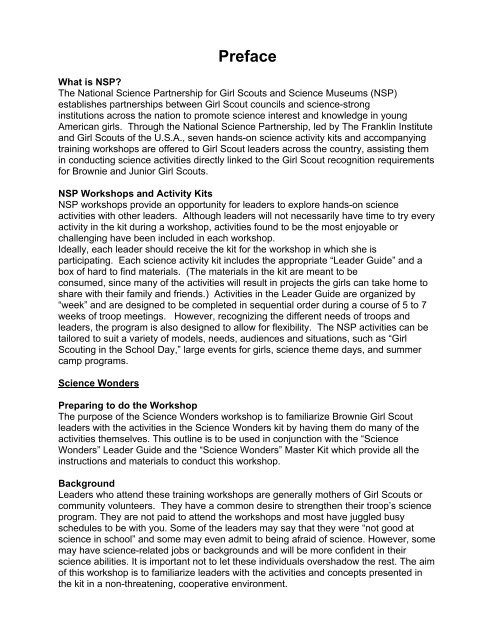
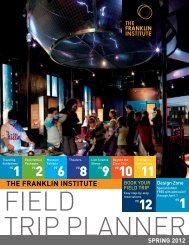
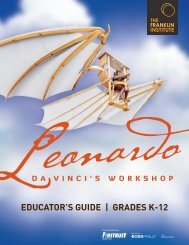
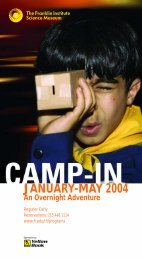
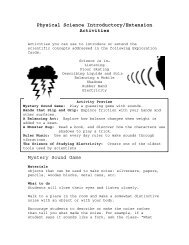
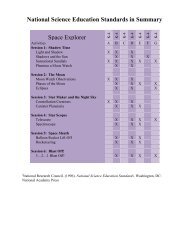
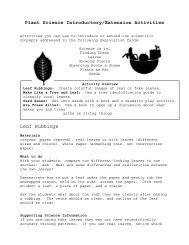

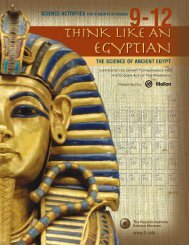
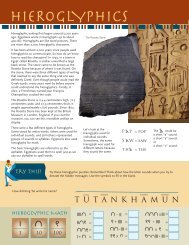
![Sir Isaac's Loft details [PDF] - The Franklin Institute](https://img.yumpu.com/20821757/1/190x146/sir-isaacs-loft-details-pdf-the-franklin-institute.jpg?quality=85)
